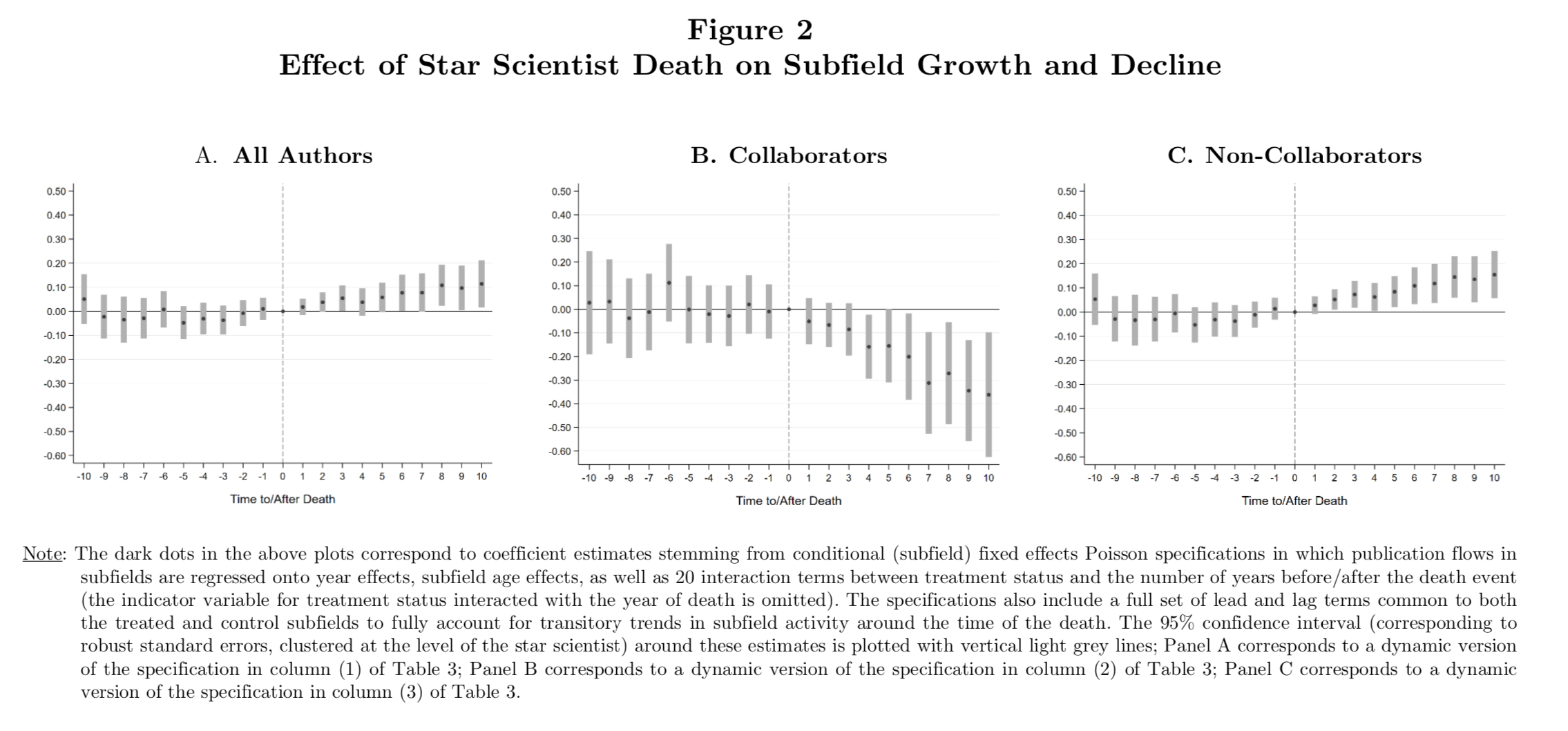You have /5 articles left.
Sign up for a free account or log in.

Wikimedia Commons
The life sciences benefit from death -- the death of star researchers. So concludes a recently published paper in American Economic Review.
But co-author Pierre Azoulay, professor of management at Massachusetts Institute of Technology, warns, tongue in cheek, that it’s not an implicit invitation to plot against life sciences luminaries.
Instead, Azoulay said in a recent interview, it’s a reason for journal editors and funding agencies to think even harder about who they’re supporting, and why.
“The idea here is not that we should start to off random senior scientists to make room for the new blood,” Azoulay said. “And if you’re successful, you are going to get to shape the evolution of the intellectual domain to which you’re contributing -- that’s part of the incentive system of science. It’s one of the things that motivates people to do what they do.”
But in the “circle of academic life,” Azoulay said, superstars may “overstay their welcome at the top of their fields.” So “we should probably think a little bit more systematically about this, and open up our practices in the realms of funding and publishing in ways that create more entry points -- and make it faster for new ideas to challenge old ones.”
Azoulay, who studies scientific developments through an economic lens, co-wrote a 2010 paper about what happens to scientists’ close collaborators when they die. The picture isn't pretty: these scientists saw a 5 to 8 percent decrease in productivity when their “suns” faded. But Azoulay got to wondering about the other side of the coin. Did the death of star researchers actually benefit their noncollaborators, in that there was simply more “air” for them now? He was most interested in the in-between moments of “normal science,” not Kuhnian paradigm shifts that inevitably lead science in new directions. In this sense, the study was a test of the Planck principle -- that scientific advancement is much more about generational change than individual scientists changing their minds.
For their study, Azoulay and his co-authors examined the relationship between the relatively early or sudden deaths of 452 eminent scientists between 1975 and 2003 and the subsequent “vitality” of the field, measured in publication rates and flow of federal funding.
The total sample of elite scientists was about 13,000, or about 5 percent of the total labor market. The average age of premature death was 61, and all scientists included in this subgroup were still active researchers before they died.
Following the deaths of star scientists, subfields saw an 8.6 percent increase in articles published by those scientists who had not previously collaborated with the late luminaries. Those papers were disproportionately likely to be highly cited. All effects are compared to control subfields, which are associated with superstars who did not die.
The effects were more pronounced for those who were previously "outsiders" to the subfields.
“To our surprise, it is not competitors from within a subfield that assume the mantle of leadership, but rather entrants from other fields that step in to fill the void created by a star’s absence,” the paper says. “Importantly, this surge in contributions from outsiders draws upon a different scientific corpus and is disproportionately likely to be highly cited.”
Consistent with the Planck theory, then, “the loss of a luminary provides an opportunity for fields to evolve in novel directions that advance the scientific frontier.”

Source: Pierre Azoulay
Asked what’s behind his findings, Azoulay said there are probably real and perceived barriers to entry into a subfield when a superstar is dominating it. Or, as the paper explains, “It does not appear to be the case that stars use their influence over financial or editorial resources to block entry into their fields, but rather that the very prospect of challenging a luminary in the field serves as a deterrent for entry by outsiders.”
Most of the entry we see occurs in those fields that lost a star who was “especially accomplished,” it continues. And even for fields that have lost a “particularly bright star, entry can still be regulated by key collaborators left behind. We find suggestive evidence that this is true in fields that have coalesced around a narrow set of techniques or ideas or where collaboration networks are particularly tight-knit. We also find that entry is more anemic when key collaborators of the star are in positions that allow them to limit access to funding or publication outlets to those outside the club that once nucleated around the star.”
Azoulay wanted to study the life sciences because they account for such a large share of federal funding, and -- less centrally -- because the material costs associated with invention aren’t as high as they are, say, in physics: getting a new biologist with a great idea going in a lab is usually easier and less resource-intensive than getting her started with a new particle accelerator.
For similar reasons, he said, the findings might be generalizable to other, relatively non-resource-intensive sciences beyond the biological. Anecdotes at least suggest that they are, he said.
Christopher Koivisto, assistant professor in biochemistry and molecular biology at the Medical University of South Carolina, said he thinks there’s “a dangerous tendency among scientists to become overly dogmatic within their respective field.” And when an “outsider makes an observation or conclusion that challenges their dogma, they are reluctant to accept it.”
Too often, he said, editors and chairs of grant review committees yield to the “dogmatic experts.” Scientists should "first evaluate the methodology," and if that's “sound and sufficient, then we should accept the new data and interpretations that challenge our current state of knowledge.”
Koivisto added, “Most of the knowledge obtained through scientific methods is contextual, such that there exist multiple nuanced truths.” In his own subfield of cancer biology and genomics, for example, he said, it's “clear that some genes can act as either a tumor suppressor or an oncogene, depending on the cell type.”
In the end, that's "fascinating and is one of the reasons that I love studying biology."
The new paper notes that it’s the first to apply microeconomics to the study of scientific evolution. Azoulay joked that social sciences might have something real to contribute to the “so-called real sciences” after all.
“Does Science Advance One Funeral at a Time?” was co-written by Christian Fons-Rosen and Joshua S. Graff Zivin. A free copy is available at Azoulay’s website.





